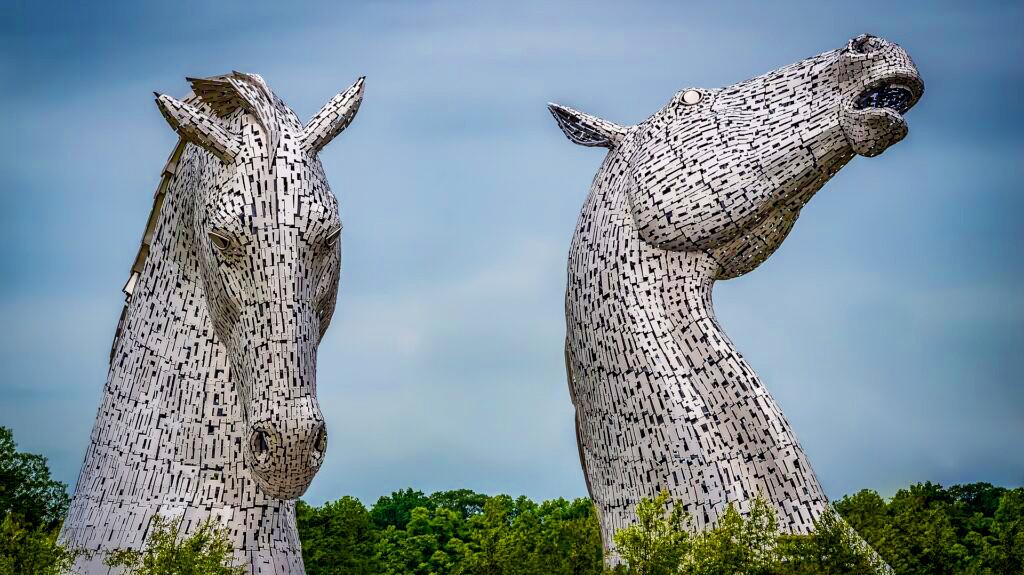
4 minute read
Breed: Scotland’s iconic Clydesdales
BREED
Scotland’s iconic Clydesdales
Born and bred in Scotland, Clydesdales have travelled far and wide, writes MATHILDE GREGOIRE.
There’s no mistaking a Clydesdale! Their size alone is enough to etch them on the memory – probably one of the reasons why, back in the day, the US brewery Budweiser chose to feature a team of
these impressive draught horses in their famous advertising campaigns. But the Clydesdale comes from humbler beginnings. In the 1700s, with the aim of improving local horses’ suitability for farm and other heavy work, Flemish stallions were imported to the county of Lanarkshire in Scotland and crossed with native mares. Shire blood was later introduced to boost the breed’s size and power, and by 1826 the horses had become known as Clydesdales in recognition of Lanarkshire’s River Clyde region.
The official seal of approval arrived when a breed society was established in 1877, followed by the export of numerous Clydesdales in the late 19th and early 20th centuries. It’s estimated that between 1884 and 1945, over 20,000 horses were shipped overseas, with around 1,600 stallions leaving Scotland in 1911 alone, bound for countries throughout the British Empire, as well as to North and South America, continental Europe, and Russia.
When Clydesdales arrived in Australia during the early days of settlement, their strength was put to good use. Capable of serious heavy lifting, the breed became popular and in 1918, the Commonwealth Clydesdale Horse Society Australia held its first meeting – an organisation which today still promotes and preserves the breed through the Clydesdale stud book.
decreased demand for horse-drawn vehicles as advances in technology resulted in the motorisation of agriculture and transport, plus the loss of numerous Clydesdales conscripted to serve in WWI, their numbers began to dwindle resulting in their near extinction in the years following WWII. While thankfully that situation is now somewhat improved, the breed is still catagorised as ‘at risk’.
The average Clydesdale stands between 16 and 18hh and weighs from 820 to 900 kilograms, although mature males can exceed 18hh and reach 1,000 kilograms.
Coupled with their imposing size, Clydesdales are characterised by their white markings and long, silky white feathers. The most common colour is bay, and while infrequent, black, grey, chestnut, and Sabino patterning (which produces roaning) does occur. By nature, they are highly intelligent, intuitive and kind, making them wonderful therapy horses.
With a strong back and long, wellmuscled hindquarters, the depth through their chest and length of leg should be approximately proportionate, a ratio which enhances the Clydesdale’s strength and pulling power.
A robust breed, and generally easy to care for, they are susceptible to chronic progressive lymphedema (CPL), a condition often seen in draught horses - particularly Clydesdales and Shires, which share a common lineage. With no known cure, CPL results in progressive swelling of the lower legs due to a reduced capacity for lymphatic drainage. It can also produce hyperkeratosis (a thickening of the outer layer of skin) and fibrosis of the lower limbs. Thought to be a genetic disorder, the cause of CPL is unknown. Nevertheless, experts recommend that affected animals should not be used for breeding.
Clydesdales are also susceptible to ‘Clyde’s itch’, a skin condition of the lower leg usually caused by an infestation of parasitic mites where feathering is heavy, and to sunburn around unpigmented areas of the face.
Due to their quiet temperament, Clydesdales are a popular addition to the British Household Cavalry, serving as drum horses and leading a variety of ceremonial parades. In order to comfortably carry the Musical Ride Officer and two silver drums each weighing 56 kilograms, drum horses must stand at a minimum of 17hh.
These days, Clydesdales are used not only in their traditional role for farm work and carting heavy loads, but also under saddle. Their calm disposition makes them easy to train and they can make excellent trail horses. These gentle giants are a popular feature in agricultural shows around Australia, most notably the Sydney and Melbourne Royals, where they steal the spotlight in the show ring both in-hand and under saddle, as well as in various demonstrations and parades.
Still the pride of Scotland, the breed has a significant place in the nation’s history and culture. Falkirk’s Helix Park is home to the largest equine sculptures in the world, a monument to Scotland’s horse powered heritage. Known as The Kelpies and created by artist Andy Scott, these two 30 metre high metal horse heads were inspired by the lochdwelling creatures of Celtic mythology, said to be horse-like beings able to adopt human form. The sculptures were modelled on the heads of Baron and Duke, two local horses, who, among many other Clydesdales, have surely earned their place in history.


Keen to know more about Clydesdales? Then drop over to clydesdalehorse.com.au and clydesdalehorsesociety.com










